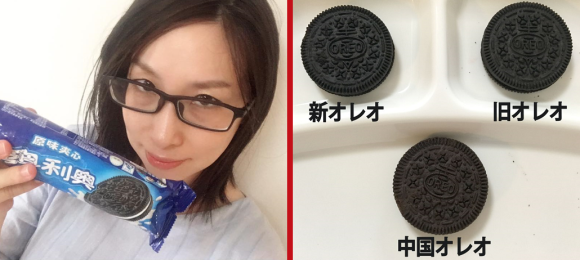
RocketNews24’s Meg pits the two cookies against each other, and also tosses made-in-China-for-China Oreos into the fray.
After months of hand-wringing by budget foodies, Yamazaki-Nabisco’s license to produce Ritz and Oreo brand snacks in Japan has run out. That means that, for the foreseeable future, the Oreos that are sold in Japan will actually be made in China, and with the dim view Japanese consumers generally take of Chinese-made products, it’s not a change that many here have been vocally happy about.
But as we’ve seen in the past, made-in-China doesn’t necessarily mean low-quality. So maybe all those doubting Thomases/Tanakas are getting worked up over nothing. After all, when our Japanese-language correspondent Meg was living in China, she made locally produced Oreos a major part of her diet, and she turned out just fine.
▼ See?
With the new, made-in-China Oreos going on sale in Japan on September 12, Meg decided to set up a three-way taste test, with the following subjects:
● The new made-in-China, sold-in-Japan Oreos, which we’ll call Oreo J Neo
● The old, made-in-Japan, sold-in-Japan, cookies, which for this test we’ll refer to as Oreo J Classic and which we still had a pack of left over
● The made-in-China, sold-in-China Oreos, which for testing purposes we’re dubbing Oreo C, which we’d procured on a recent trip to China
First up, the graphics on the package of the Oreo J Neo are different from those of the J Classic. As a matter of fact, the photograph seems to be the exact same one that’s used on the Oreo C bag.
▼ Oreo J Neo (top left), J Classic (top right), and C (bottom)
▼ The parallels between the Oreo J Neo and C packages continue on the back.
We tore open all three packages and grabbed one cookie from each. Once again, two of them looked very similar, except this time the Oreo C was the odd one out, with a lighter brown biscuit than either of the types of Oreos we’d purchased in Japan.
▼ J Neo (top left), J Classic (top right), and C (bottom)
It makes sense that the J Classic and J Neo look alike, though. The J Neo is specifically being made for export to Japan, so it’s going to be designed to mesh with Japanese expectations in order to capitalize on all the goodwill the Oreo brand has built up in the country.
The story was much the same when we twisted the cookies apart to take a look at their cream fillings. Once again, it’s hard to visually distinguish between the J Neo and Classic, while the Oreo C filling looks noticeably more buttery and has a less solid consistency.
▼ J Neo (top left), J Classic (top right), and C (bottom)
But just like people don’t go to the Louvre to nibble on the paintings, we didn’t buy these cookies to admire their aesthetics. It was time to eat them, and to Meg’s surprise, all of them taste different from each other.
Meg’s taste test notes:
● Oreo J Classic: The biscuit is crisp and moist, with the strongest bitterness of the three. The cream is very moist, with a level of sweetness between that of the other two varieties.
● Oreo J Neo: A light, crisp biscuit with suppressed bitter notes and more sweetness. The cream is moist and mildly sweet, less so than the other two types, but very refreshing.
● Oreo C: The biscuit is hard enough to be called crunchy, and very sweet. The filling is the sweetest of the three, and has the consistency of old-fashioned butter cream.
So in the end, we’ve got three different cookies, and because they’re all tasty in their own way, we really can’t call any one of them a winner or loser. They’re all enjoyable in their own unique way, so really the only thing to do is choose the one that matches what you’re in the mood for.
If that happens to be the J Classics, though, you’ll want to resist any urges to go into a feeding frenzy on them, since we’re not going to be getting any more.
Images ©RocketNews24
[ Read in Japanese ]

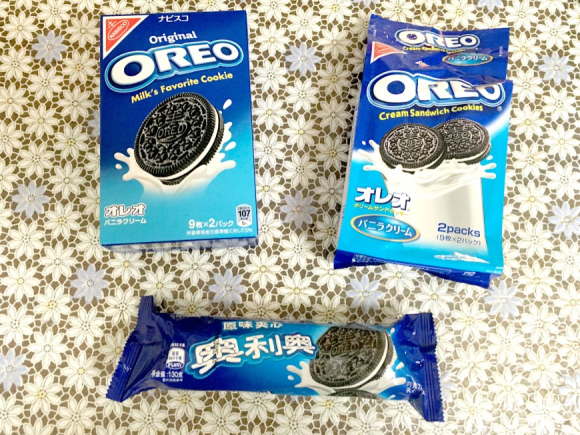
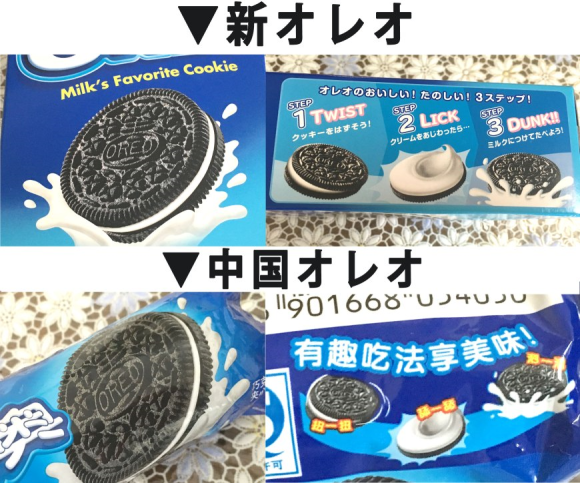
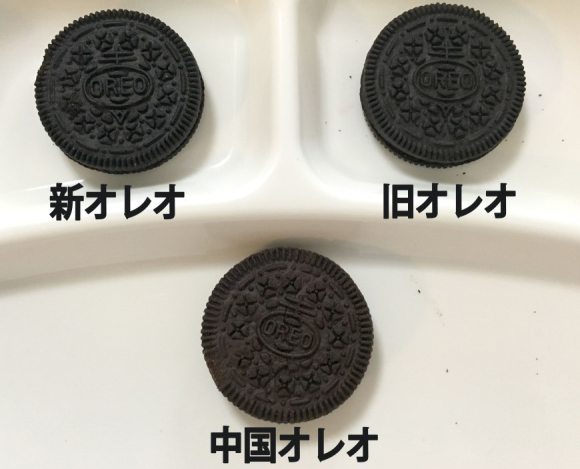
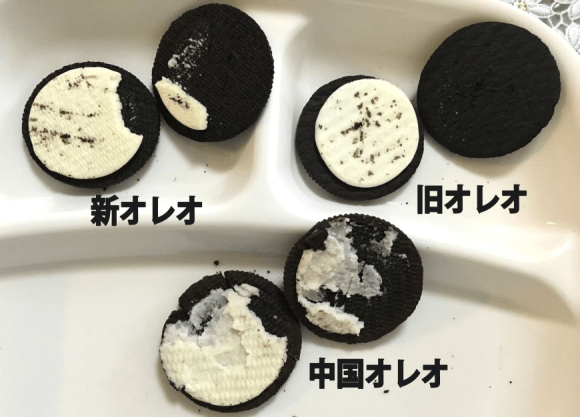
 Japan’s new imitation Oreos are here, but how do they compare to the made-in-China real deal?
Japan’s new imitation Oreos are here, but how do they compare to the made-in-China real deal? We try the new full-sized matcha Oreo cookies from Japan
We try the new full-sized matcha Oreo cookies from Japan Our batch of homemade Oreos – Why didn’t we think of this before?
Our batch of homemade Oreos – Why didn’t we think of this before? Pizza Hut’s new Oreo pizza is like nothing we’ve ever eaten before
Pizza Hut’s new Oreo pizza is like nothing we’ve ever eaten before Sakura Oreos set to blossom in Japan this spring and fill our hearts/stomachs with happiness
Sakura Oreos set to blossom in Japan this spring and fill our hearts/stomachs with happiness Private booths are coming to Japan’s Shinkansen bullet trains even sooner than we’d thought【Video】
Private booths are coming to Japan’s Shinkansen bullet trains even sooner than we’d thought【Video】 Rakuten randomly offers 58 New Year’s osechi feasts in Japan, but did we get a star or a dud?
Rakuten randomly offers 58 New Year’s osechi feasts in Japan, but did we get a star or a dud? The Purple Lucky Bag from Village Vanguard is an extra-large waste of money
The Purple Lucky Bag from Village Vanguard is an extra-large waste of money Japanese beef bowl chain Sukiya’s 2026 Smile Box lucky bag basically pays for itself
Japanese beef bowl chain Sukiya’s 2026 Smile Box lucky bag basically pays for itself Princesses, fruits, and blacksmiths: Study reveals the 30 most unusual family names in Japan
Princesses, fruits, and blacksmiths: Study reveals the 30 most unusual family names in Japan Giant teabag-shaped envelope now available to spice up your look
Giant teabag-shaped envelope now available to spice up your look McDonald’s Japan made two almost identical commercials, with one tiny, touching difference【Vids】
McDonald’s Japan made two almost identical commercials, with one tiny, touching difference【Vids】 Visit the birthplace of the Japanese daruma in Gunma Prefecture
Visit the birthplace of the Japanese daruma in Gunma Prefecture JAL system makes air travel easier and lets you keep laptops, liquids in bag for security check
JAL system makes air travel easier and lets you keep laptops, liquids in bag for security check Pokémon Valentine’s Day chocolates from Japan are just the thing for lovers who love Pokémon
Pokémon Valentine’s Day chocolates from Japan are just the thing for lovers who love Pokémon Starbucks Japan ready to get Year of the Horse started with adorable drinkware and plushies【Pics】
Starbucks Japan ready to get Year of the Horse started with adorable drinkware and plushies【Pics】 Hayao Miyazaki says Happy New Year to Studio Ghibli fans with new art for Year of the Horse
Hayao Miyazaki says Happy New Year to Studio Ghibli fans with new art for Year of the Horse We found possibly the quietest Japanese-style hotel in Tokyo’s bustling Shinjuku district
We found possibly the quietest Japanese-style hotel in Tokyo’s bustling Shinjuku district Cup Noodle tries an authentic Jiro-style ramen, but something’s not quite right
Cup Noodle tries an authentic Jiro-style ramen, but something’s not quite right The best Starbucks Japan Frappuccinos we want to drink again in 2026
The best Starbucks Japan Frappuccinos we want to drink again in 2026 We revisited Sweets Paradise after a decade to see if Japan’s dessert buffet still delivers
We revisited Sweets Paradise after a decade to see if Japan’s dessert buffet still delivers That time Seiji called JASRAC to ask why he didn’t get paid royalties for his song being on TV
That time Seiji called JASRAC to ask why he didn’t get paid royalties for his song being on TV Japan’s oldest largetooth sawfish in captivity back on display in Mie Prefecture
Japan’s oldest largetooth sawfish in captivity back on display in Mie Prefecture Pizza Hut Japan’s hot lucky bags are perfect for a New Year’s pizza party
Pizza Hut Japan’s hot lucky bags are perfect for a New Year’s pizza party 7-Eleven Japan starts new temporary luggage storage service in over 300 branches
7-Eleven Japan starts new temporary luggage storage service in over 300 branches Disillusionment at Tsukiji’s tourist-target prices led us to a great ramen restaurant in Tokyo
Disillusionment at Tsukiji’s tourist-target prices led us to a great ramen restaurant in Tokyo Starbucks teams up with 166-year-old Kyoto doll maker for Year of the Horse decorations【Photos】
Starbucks teams up with 166-year-old Kyoto doll maker for Year of the Horse decorations【Photos】 Tokyo considering law requiring more trash cans following litter increase in heavily touristed area
Tokyo considering law requiring more trash cans following litter increase in heavily touristed area Tokyo’s Tsukiji sushi neighborhood asks tour groups to stay away for the rest of the month
Tokyo’s Tsukiji sushi neighborhood asks tour groups to stay away for the rest of the month Tokyo event lets you travel back in time, for free, to celebrate 100 years since Showa era start
Tokyo event lets you travel back in time, for free, to celebrate 100 years since Showa era start Japan may add Japanese language proficiency, lifestyle classes to permanent foreign resident requirements
Japan may add Japanese language proficiency, lifestyle classes to permanent foreign resident requirements Sanrio theme park in Japan announces plans to expand into a Sanrio resort
Sanrio theme park in Japan announces plans to expand into a Sanrio resort Stamina-destroying “Paralysis Noodles” are Tokyo’s newest over-the-top ramen innovation
Stamina-destroying “Paralysis Noodles” are Tokyo’s newest over-the-top ramen innovation Survey asks foreign tourists what bothered them in Japan, more than half gave same answer
Survey asks foreign tourists what bothered them in Japan, more than half gave same answer Japan’s human washing machines will go on sale to general public, demos to be held in Tokyo
Japan’s human washing machines will go on sale to general public, demos to be held in Tokyo Japan’s deadliest food claims more victims, but why do people keep eating it for New Year’s?
Japan’s deadliest food claims more victims, but why do people keep eating it for New Year’s? We deeply regret going into this tunnel on our walk in the mountains of Japan
We deeply regret going into this tunnel on our walk in the mountains of Japan Studio Ghibli releases Kodama forest spirits from Princess Mononoke to light up your home
Studio Ghibli releases Kodama forest spirits from Princess Mononoke to light up your home Major Japanese hotel chain says reservations via overseas booking sites may not be valid
Major Japanese hotel chain says reservations via overseas booking sites may not be valid Put sesame oil in your coffee? Japanese maker says it’s the best way to start your day【Taste test】
Put sesame oil in your coffee? Japanese maker says it’s the best way to start your day【Taste test】 No more using real katana for tourism activities, Japan’s National Police Agency says
No more using real katana for tourism activities, Japan’s National Police Agency says Starbucks Japan reveals new sakura drinkware collection, inspired by evening cherry blossoms
Starbucks Japan reveals new sakura drinkware collection, inspired by evening cherry blossoms Updated cherry blossom forecast shows extra-long sakura season for Japan this year
Updated cherry blossom forecast shows extra-long sakura season for Japan this year Let’s try making our own Chinese McDonald’s Oreo-Spam burgers!【SoraKitchen】
Let’s try making our own Chinese McDonald’s Oreo-Spam burgers!【SoraKitchen】 Artist carves cute Studio Ghibli characters into Oreo cookie filling 【Video】
Artist carves cute Studio Ghibli characters into Oreo cookie filling 【Video】 How are Starbucks Japan’s Baked Cheesecake Frappuccinos? We find out 【Taste test】
How are Starbucks Japan’s Baked Cheesecake Frappuccinos? We find out 【Taste test】 Krispy Kreme set to release new “Sweet America” range of doughnuts in Japan
Krispy Kreme set to release new “Sweet America” range of doughnuts in Japan Taste the beginning of the end for Japanese Ritz: Wasabi & Cheddar / Tarako & Cream Cheese
Taste the beginning of the end for Japanese Ritz: Wasabi & Cheddar / Tarako & Cream Cheese One of Japan’s best-kept ice cream secrets…is hiding at a home improvement center? 【Taste test】
One of Japan’s best-kept ice cream secrets…is hiding at a home improvement center? 【Taste test】 Is Japan’s new pudding ice cream bar too much deliciousness to handle? 【Taste test】
Is Japan’s new pudding ice cream bar too much deliciousness to handle? 【Taste test】 We head to KFC in China to chow down on a pretty pink rose-flavoured burger【Taste test】
We head to KFC in China to chow down on a pretty pink rose-flavoured burger【Taste test】 Are Japanese rice cookers really better than Chinese ones? We test it out and get some surprises
Are Japanese rice cookers really better than Chinese ones? We test it out and get some surprises Brand-new premium sake Kit Kats are out in Japan, and they’re amazing【Taste test】
Brand-new premium sake Kit Kats are out in Japan, and they’re amazing【Taste test】 Deep-fried sushi exists in Japan, and here’s where to try it【Taste test】
Deep-fried sushi exists in Japan, and here’s where to try it【Taste test】 We try the new sakura Frappuccino from Starbucks Japan【SoraNews24 Taste Test】
We try the new sakura Frappuccino from Starbucks Japan【SoraNews24 Taste Test】 We try the latest crazy chip flavour from Japan: Strawberry shortcake 【Taste test】
We try the latest crazy chip flavour from Japan: Strawberry shortcake 【Taste test】 Soy sauce on pancakes? We try the newest dessert idea from a century-old soy maker【Taste test】
Soy sauce on pancakes? We try the newest dessert idea from a century-old soy maker【Taste test】 Starbucks’ new matcha cheese Frappuccino is here, but can this crazy combo work?【Taste test】
Starbucks’ new matcha cheese Frappuccino is here, but can this crazy combo work?【Taste test】
Leave a Reply